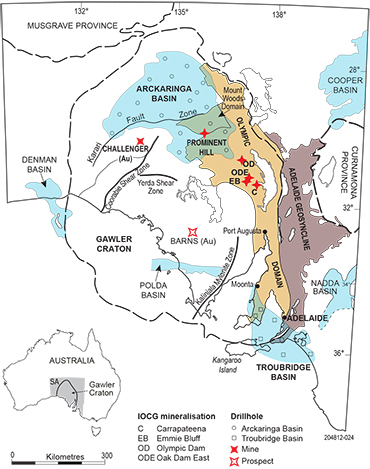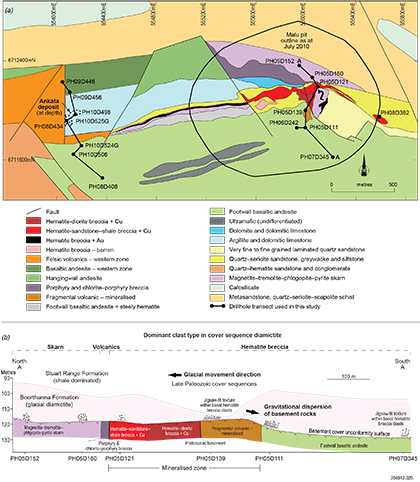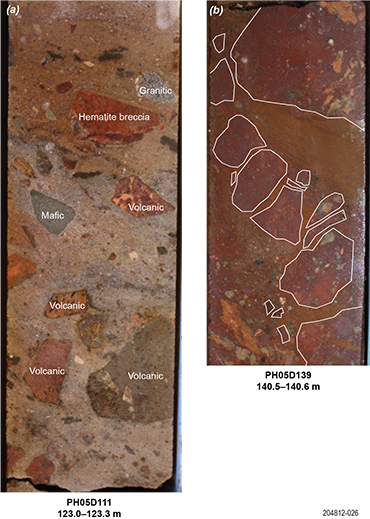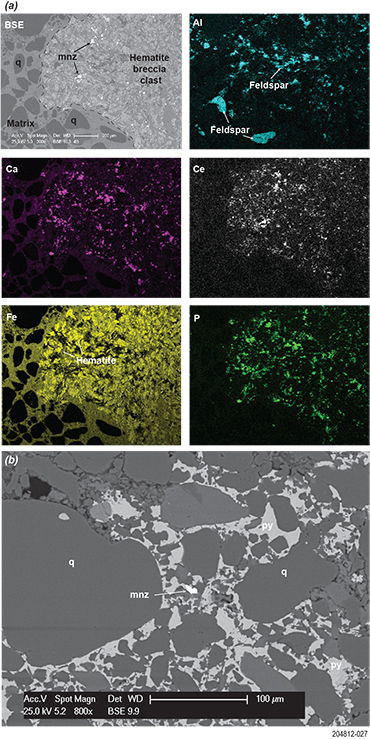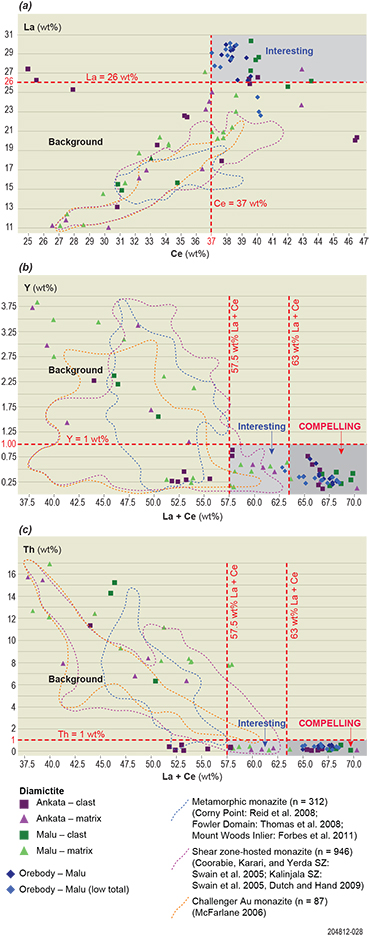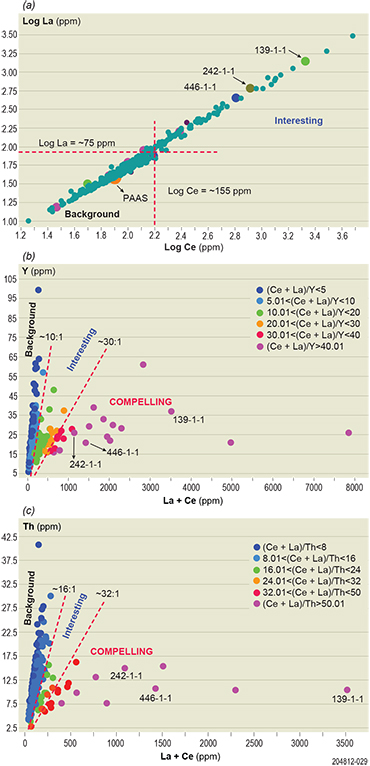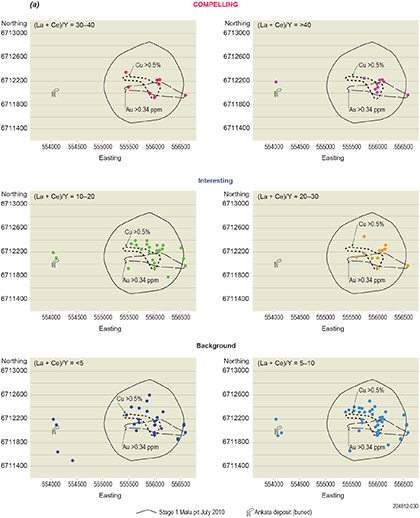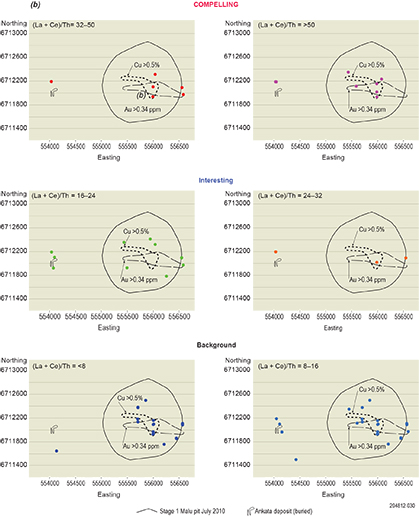Caroline Forbes1, Dave Giles1*, Hamish Freeman2, Mick Sawyer2 and Verity Normington1†
1 Deep Exploration Technologies Cooperative Research Centre (DET CRC); Tectonics Research and Exploration (TRaX), Department of Earth Sciences, University of Adelaide
2 OZ Minerals Limited
* Now at Future Industries Institute, University of South Australia
† Now at Northern Territory Geological Survey, Department of Mines and Energy
Peer reviewed (Department of State Development and externally)
Download this article as a PDF (1.2MB); cite as MESA Journal 81, pages 18–29
Introduction
Figure 1 Location of the Proterozoic Olympic Domain and late Paleozoic basins including the Arckaringa and Troubridge basins. Known major IOCG deposits including the Prominent Hill deposit are highlighted. Modified after Alley (1995) and Conor et al. (2010).
The Gawler Craton in South Australia (Fig. 1) has high economic potential, including hosting major iron oxide – copper–gold (IOCG) mineralisation (e.g. Skirrow et al. 2002, 2007; Groves et al. 2010). Light rare earth elements (LREE) are commonly enriched within these IOCG deposits (e.g. Oreskes and Einaudi 1990; Belperio, Flint and Freeman 2007; Davidson et al. 2007) and are host within a number of phases including monazite ((Ce,La,Th)PO4; e.g. Belperio, Flint and Freeman 2007), which is a resistate phase that can withstand processes of physical transport and weathering without significant chemical alteration (e.g. Scott and Pain 2008). Recognition of this elevated LREE signature within monazite-bearing rocks that have been transported away from mineralised zones has the potential to be used as a geochemical vector towards IOCG mineralisation.
Here we summarise the findings of Forbes et al. (2015) and show that hydrothermal monazite within the mineralised zone of the Prominent Hill IOCG orebody has a characteristic geochemical signature that can be recognised in monazite grains that have been physically reworked and redistributed into the overlying Permian glacial sequences. This characteristic signature can also be recognised in whole-rock geochemistry under the assumption that a majority of LREE in the cover sequence are host within monazite. Criteria for exploration of Prominent Hill style IOCG deposits is given and dispersion of the geochemical footprint related to mineralisation is discussed.
Regional geology
The Gawler Craton includes Paleo- to Mesoproterozoic rocks of the Olympic Domain, which is host to significant mineralisation including the Olympic Dam and Prominent Hill IOCG deposits (Fig. 1). Ore genesis is considered to have occurred c. 1600–1570 Ma (e.g. Belperio, Flint and Freeman 2007; Davidson et al. 2007; Skirrow et al. 2007; Reid et al. 2011). IOCG deposits within the Olympic Domain are characteristically enriched in LREE. Within and proximal to the Prominent Hill deposit, LREE are host within minerals including monazite, florencite, bastnäsite and Ce-bearing apatite (e.g. Belperio, Flint and Freeman 2007).
In the Prominent Hill area, the Paleo- to Mesoproterozoic basement rocks are unconformably overlain by glacial diamictite of the Boorthanna Formation that was deposited during Permian glacial activity (Alley 1995; Krieg 1995). The inferred direction of glacial movement was northwards (e.g. Crowell and Frakes 1971; Veevers 2006). Components of the mineralisation were physically transported and dispersed to the north of the orebody during this glacial activity and are now preserved within the Boorthanna Formation diamictite (Gogoll 2007; Forbes et al. 2015).
Regionally, the Boorthanna Formation stratigraphically sits at the base of cover sequences within the Arckaringa Basin, which covers an extensive region of central South Australia and overlies the northwestern portion of the Olympic Domain (Fig. 1). Stratigraphic equivalent diamictites to the Boorthanna Formation are also reported in other late Paleozoic basins within South Australia, including the Troubridge, Denman, Cooper, Nadda and Polda Basins (e.g. Alley 1995). Of these, the Troubridge Basin is the only one to overlap with the Olympic Domain (Fig. 1).
Methodology
Figure 2 (a) Map of the Prominent Hill area showing basement geology (after OZ Minerals 2013) and the location of the Malu and Ankata deposits and the two drillhole transects used in this study. (b) Cross-section over the Malu orebody showing the dominant clast types within the Boorthanna Formation (after Forbes et al. 2015). Line of section is located in 2a.
The Boorthanna Formation diamictite was logged and sampled from 15 drillholes over the Malu and smaller Ankata mineralised zones in the Prominent Hill area. The drillholes chosen form two ~N–S transects so that geochemical components dispersed due to the northward movement of the glacier (e.g. Crowell and Frakes 1971) could be mapped out (Fig. 2), and contain well preserved Boorthanna Formation diamictite at the basement–cover interface. The basal 1–8 m of diamictite was logged in detail to note the clast type, size, shape and distribution as well as sedimentological features. The top ~50 cm of basement was logged within each drillhole. It is noted that these local descriptions do not always match the broader lithology described in the OZ Minerals database and shown in Figure 2. Fourteen samples representative of different clast types within the diamictite were selected for analysis.
Petrological analysis and qualitative elemental maps were used to identify LREE-bearing phases within the diamictite clasts and matrix. Scanning electron microscope (SEM) mapping was done using a XL40 SEM with EDAX Genesis energy dispersive X-ray analyser at Adelaide Microscopy, University of Adelaide. Operating conditions are outlined in Forbes et al. (2015).
The quantitative REE chemistry of monazite grains proximal to and within mineralised zones was determined via electron microprobe analysis. Thirteen samples of diamictite were selected so that data representing monazite from a variety of clast types and from within the diamictite matrix could be collected. Two samples from within the Malu deposit were also analysed. Detail of diamictite and Malu orebody samples is given in Forbes et al. (2015). Additionally, data was collected from metamorphic monazite within two metapelite samples (samples 1471270 and 1039404) taken from the Skylark Metasediments in the northern Mount Woods Domain (Forbes et al. 2011, 2012). These samples were used as they are from the same region that hosts mineralisation in the Prominent Hill area, and are not associated with any known mineralisation. Analyses were done using a Cameca SX51 electron microprobe at Adelaide Microscopy. Details of operating conditions and data are given in Forbes et al. (2015).
Fourteen samples used for elemental mapping and electron microprobe analysis were also used for bulk rock geochemical analysis. Details of samples are given in Forbes et al. (2015). Samples were analysed at Genalysis Laboratories in Adelaide using standard fire assay, inductively coupled plasma - mass spectrometry (ICP-MS) and ICP - optical emission spectrometry (ICP-OES) techniques. Whole-rock geochemical data for 396 diamictite samples over the Malu and Ankata deposits was also extracted from the OZ Minerals database and used for comparison with the chemistry of samples collected in this study. The OZ Minerals samples were analysed at Amdel Laboratories, Adelaide, using standard fire assay and ICP-OES techniques. Data and detail of individual element analysis are given in Forbes et al. (2015).
Results
Clast types within Permian glacial sediments
Figure 3 Representative photos of the Boorthanna Formation diamictite from Forbes et al. (2015). (a) Example of angular hematite breccia clasts, rounded to subangular volcanic clasts and rounded granitic clasts. The matrix of the diamictite changes from grey (bottom) to brown (top). (b) Example of jigsaw-fit hematite breccia clasts (outlined in white) preserved within 10 cm of the basement–cover interface. Drillholes are located in Figure 2a.
Clast lithologies within the Boorthanna Formation diamictite are highly variable in composition and shape, and comprise angular clasts of hematite breccia, volcanics and skarn/carbonate; angular to subrounded clasts of volcanics, carbonate and mudstone; and rounded granite, volcanics, metasediments and quartzites (Fig. 3). Angular volcanic clasts are more commonly hematite altered and more mafic in composition compared to the rounded volcanic clasts. Clasts range in size from <5 mm to 15 cm, with rare clasts up to 70 cm length. Sulfides of the same mineralogy preserved in the underlying mineralisation are occasionally preserved within clasts and at clast–matrix boundaries. The diamictite matrix consists of clay- to coarse sand-sized grains interbedded with silt- to clay-sized grains comprising rounded quartz and feldspar grains with a carbonate cement. Dark bands comprising interstitial pyrite are common throughout the diamictite. The composition of the basement logged at the base of the drillholes is variable. The contact between the basement and overlying cover sequence is sharp. Detail of the logging is given in Forbes et al. (2015).
Rare earth element hosts
Figure 4 Representative images after Forbes et al. (2015) showing residence of LREE within the resistate phase, monazite. (a) Back scattered electron (BSE) image of hydrothermal monazite within a hematite breccia clast in diamictite overlying the Malu orebody (PH05D152); SEM elemental maps showing concentrations of Al, Ca, Ce, Fe and P within the same area shown in the BSE image. Bright areas indicated higher concentrations of the mapped element. Monazite is represented by high concentrations of Ce and P and low concentrations of Ca. Hematite is highlighted as elevated Fe. Al highlights minerals such as feldspars. (PH05D139). (b) BSE image showing detrital monazite within the diamictite matrix. Drillholes are located in Figure 2a. Mineral abbreviations: mnz monazite; py pyrite; q quartz.
Element mapping showed that LREE are dominantly accommodated within monazite throughout samples from both the Malu and Ankata traverses, and that monazite grains are preserved within the clasts (e.g. Fig. 4a) and matrix (e.g. Fig. 4b) of the diamictite (Forbes et al. 2015). Within clasts, monazite is most commonly present within hematite breccia clasts (Fig. 4a) and to a lesser extent fine-grained volcanic clasts (Forbes et al. 2015). The monazite commonly occurs as individual grains up to 30 µm length, and occasionally up to 100 µm, with variably rounded to irregular shape. Monazite also occurs as fine-grained (<5 µm) aggregates up to 30 x 50 µm size and occasionally up to 500 µm length. Patches of fine (<~30 µm), disseminated grains and monazite overgrowths over apatite are also observed. LREE were observed in three samples as an oxide phase in veins, as fine disseminated grains and at the clast–matrix boundary (Forbes et al. 2015). A possible LREE-bearing apatite was observed within a volcanic clast in one sample from the Malu traverse (Forbes et al. 2015).
Monazite occurs throughout the matrix as rounded to subrounded grains up to 30 µm length. The grains are preserved within the carbonate cement, within the interstitial pyrite accumulations (Fig. 4b) and as inclusions within rounded quartz and K-feldspar grains (Forbes et al. (2015).
In general, monazite is nonexistent to rare or in low to moderate modal proportions in the southern drillholes of both traverses (Malu: PH05D111, PH05D242, PH07D345; Ankata: PH08D408; Fig. 2). Monazite is present at moderate to high proportions in all other drillholes.
Monazite chemistry
Figure 5 (a) Ce vs La, (b) La + Ce vs Y and (c) La + Ce vs Th diagrams showing electron microprobe spot analysis data from monazite within the Malu orebody and from Boorthanna Formation diamictite overlying the Malu and Ankata mineralised zones. Data for other monazite sourced from the Gawler Craton is shown for comparison (see Fig. 1 for localities). Exploration criteria for monazite spot analysis data is highlighted. Modified after Forbes et al. (2015).
Data was separated into four groups based on the deposit and textural location of the grains within the diamictite: Malu clast-hosted; Malu matrix-hosted; Ankata clast-hosted; and Ankata matrix-hosted. Data is shown in Figure 5 using Ce vs La, La + Ce vs Y and La + Ce vs Th diagrams as these were determined to be the most appropriate for showing variations between the data groups. All data is given in Forbes et al. (2015). Overall, clast-derived monazite grains have high La and Ce and low Y and Th content (Fig. 5). Greater scatter was observed in the Ankata clast-hosted monazite data compared to the Malu clast-hosted monazite data (Fig. 5). The matrix-derived monazite grains are scattered across the diagrams (Fig. 5).
Monazite grains derived from the Malu orebody are characteristically enriched in La and Ce, and depleted in Y and Th (Fig. 5). The chemistry of these grains shows tight clusters on the diagrams shown in Figure 5.
The metamorphic monazite from the Mount Woods Domain grew under prograde granulite facies conditions at c. 1.615 Ga (Forbes et al. 2011) contemporaneously with mineralisation in the Prominent Hill region (Belperio, Flint and Freeman 2007). Overall, the LREE, Y and Th composition of metamorphic monazite from the Mount Woods Domain was found to be variable (Fig. 5).
Whole-rock geochemistry
Of significance to this study are the La, Ce, Cu, Au, Y, Th and Zr contents of the samples (Fig. 6). Samples dominated by hematite breccia, hematite-altered volcanic and skarn clasts, respectively, and containing minimal matrix material show the highest La and Ce contents (Fig. 6a, b) and are not coincident with elevated Cu and/or Au (Forbes et al. 2015). It is noted that samples dominated by altered clasts do not always contain elevated LREE content (Forbes et al. 2015). Higher Y content generally correlates with high LREE content and the lowest Y concentration is in the sample with the lowest La, Ce and Th content. High Th and Zr concentrations do not correspond with high LREE content (Forbes et al. 2015).
Discussion
Distribution of the diamictite clasts
The broad variation in composition and morphology of the clasts within the Boorthanna Formation overlying the Malu and Ankata mineralisation suggests a number of source rocks including locally derived clasts from the mineralised and unmineralised basement rocks, and distally derived sources that may include the Gawler Range Volcanics, Hiltaba Granite Suite and metamorphic rock packages throughout the Gawler Craton such as the Mount Woods Domain (Fig. 1; Forbes et al. 2015). The distribution of the clasts is dependent on the type of glacial activity (e.g. ice sheet or ice tongue), the direction of movement of the glacier and paleotopography. In the case of the Prominent Hill area, the inferred direction of movement of the glacier is northwards (Crowell and Frakes 1971; Veevers 2006) and was associated with ice sheet activity (Forbes et al. 2015). A paleohigh in the centre of the Malu traverse will also have influenced clast distribution (Fig. 2b; Forbes et al. 2015).
LREE mineral host
LREE within IOCG deposits in the Gawler Craton, including at Prominent Hill, were introduced via hydrothermal fluids and subsequently the grains that host LREE are hydrothermal in origin (e.g. Oreskes and Einaudi 1990; Belperio, Flint and Freeman 2007; Groves et al. 2010). In the Prominent Hill area, La- and Ce-rich monazite is associated with broad iron oxide alteration halos associated with mineralised zones (Belperio, Flint and Freeman 2007). Within the Malu mineralisation, LREE are also host within Ce-apatite, bastnäsite and florencite (e.g. Belperio, Flint and Freeman 2007).
The principal LREE host within the Boorthanna Formation overlying the Malu and Ankata mineralisation is monazite with minor amounts host within LREE oxides. The absence of other LREE phases within the diamictite clasts may be due to the clasts having been derived from a region of the deposit where most LREE were accommodated within monazite, and/or that other LREE-bearing phases are not as resistive as monazite to physical transport and weathering processes and therefore underwent alteration and breakdown during the Permian glacial activity. Monazite grains within diamictite clasts have similar morphology to those reported in the Prominent Hill mineralisation (e.g. Belperio, Flint and Freeman 2007; Fig. 4). These grains are mostly associated with angular hematite- or skarn-altered clasts that can contain sulfides. These clasts, and therefore the monazite within them, are interpreted to have been derived from the immediately underlying basement.
Comparison of monazite chemistry
Figure 6 Whole-rock geochemical plots using data collected in this study (large dots) and extracted from the OZ Minerals geochemical database (small teal dots). (a) Log Ce vs log La plot showing threshold values between background and interesting data. Composition of post-Archean average Australian sedimentary rock (PAAS: McLennan 1989) is shown for reference. (b) La + Ce vs Y and (c) La + Ce vs Th plots coloured for ratios of (La + Ce):Y and (La + Ce):Th respectively and showing fields of background, intermediate and high ratios. Sample 139-1-1 dominated by hematite breccia clasts; sample 242-1-1 dominated by hematite-altered volcanic clasts; sample 446-2-1 dominated by skarn clasts. See text for explanation. Modified after Forbes et al. (2015).
The chemistry of hydrothermal monazite grains derived from the Malu deposit and of clast-derived monazite grains from the Malu traverse show similar chemistry and cluster together on Ce vs La, La + Ce vs Y and La + Ce vs Th diagrams (Fig. 5). Clast-derived monazite grains from the Ankata traverse show a broader spread in composition (Fig. 5). A small number (~5) of the Ankata clast data plot in the same area as monazite grains derived from the Malu deposit, indicating the monazite grains all have similar compositions (Fig. 5). The variation in composition may reflect the composition of monazite grains within the Ankata deposit itself, however, no data from the Ankata deposit is available for comparison. Additionally, as the Ankata deposit itself was not exposed during the Permian glaciation (OZ Minerals 2013), the clast-derived monazite grains over the Ankata traverse may not have been directly sourced from mineralisation, and may be derived from an alteration zone surrounding the deposit that was not as strongly LREE enriched as within the orebody itself. Furthermore, the low Th content (<0.5 wt%) of the clast-derived and Malu orebody-derived monazite grains is supportive of a hydrothermal origin (e.g. Schandl and Gorton 2004).
The chemistry of matrix-derived monazite from both the Malu and Ankata traverses is variable (Fig. 5). The chemistry of a small number of these grains overlaps with the chemistry of the Malu orebody- and clast-derived monazite grains, suggesting it is plausible that some of the matrix grains were derived from mineralisation. However, the composition of a majority of matrix-derived grains overlaps with chemistry of monazite from other regions of the Gawler Craton, including metamorphic monazite, monazite within major shear zones and monazite derived from the Challenger Au deposit (Fig. 5).
The Ce vs La, La + Ce vs Y and La + Ce vs Th diagrams shown in Figure 5 highlight the elevated LREE and depleted Y and Th content of the orebody- and clast-derived monazite grains compared to the matrix-derived grains and other monazite throughout the Gawler Craton. Overall, monazite grains that have La + Ce content >63 wt% and Y and Th content <1 wt% can be considered of interest as these chemical characteristics are similar to the orebody-derived monazite grains. The correlation between the chemistry of orebody- and clast-derived monazite grains shows that the characteristic chemical signature of the orebody-derived grains may be kept mostly unaltered within monazite grains that have undergone physical transportation and possibly weathering during glacial activity and reworking to form the diamictite.
Exploration criteria using monazite chemistry
The characteristic LREE, Y and Th chemistry of the orebody- and clast-derived monazite grains is compelling evidence that compositional characterisation of monazite can be used as a geochemical vector towards mineralisation. In this case, monazite grains that have >63 wt% La + Ce and <1 wt% Y and Th can be considered anomalous. Monazite grains with lower La + Ce and higher Y and Th content can be considered background, and includes the metamorphic, shear zone hosted, Challenger deposit and most of the matrix-hosted monazite data. The monazite chemistry can therefore be used to distinguish general areas of interest on the Ce vs La, La + Ce vs Th and La + Ce vs Y diagrams, which could be used in exploration. One area of interest is identified on the Ce vs La diagram where Ce is >37 wt% and La is >26 wt% (Fig. 5a). Two areas of interest are defined on each of the La + Ce vs Y and La + Ce vs Th diagrams. Anomalous data is considered that with La + Ce >63 wt% and Y or Th <1 wt%. This is the region within which the orebody- and clast-derived monazite data plots (Fig. 5b). Interesting data is where 57.5 wt% < La + Ce < 63 wt% and Y or Th is <1 wt%. This data lies between background and highly anomalous data (Fig. 5b). Monazite with La + Ce content <57.5 wt% is considered background (Fig. 5b, c). These criteria can be used to identify Prominent Hill style mineralisation, but have not yet been applied to other IOCG deposits within the Gawler Craton.
Whole-rock geochemical trends
A sample containing LREE-enriched monazite should yield high La and Ce content in the bulk geochemical data. Assuming no other Y- or Th-bearing phases are present, the bulk chemistry should also reflect low Y and Th content. Following from the Ce vs La, La + Ce vs Y and La + Ce vs Th plots used to distinguish the electron microprobe data, these plots are also used to assess the whole-rock geochemical data (Fig. 6). Samples containing clasts associated with hematite and skarn alteration preserve the highest Ce and La content (Fig. 6a). However, the Y and Th content of these samples is not low relative to the remainder of the whole-rock samples (Fig. 6b, c), which may reflect that the samples contain other Y- and Th-bearing phases (e.g. xenotime and zircon). This demonstrates that the low Y- and Th-signature of the orebody-derived monazite grains may not always be seen in the whole-rock chemistry. Therefore, the whole-rock geochemistry Y and Th concentrations should be considered on an individual basis and used as supportive evidence in identifying anomalous geochemical signatures.
Probability plots can be used to set thresholds in the whole-rock geochemical data to generalise what may be considered ‘background’, ‘interesting’ and ‘compelling’ data (Forbes et al. 2015). Forbes et al. (2015) show that values of La >~75 ppm and Ce >~155ppm are above background and are therefore considered interesting (Fig. 6a).
Threshold ratios (La + Ce):Y set from inflection points on the probability plots are ~10:1 and ~30:1, and for (La + Ce):Th are ~16:1 and ~32:1 (Forbes et al. 2015). The resulting zones of background, intermediate and anomalous data based on the inflection point thresholds are shown in the La + Ce vs Y (Fig. 6b) and La + Ce vs Th (Fig. 6c) diagrams. These plots demonstrate that most data has background values, and how intermediate and anomalous data can be distinguished from background data.
Exploration using whole-rock geochemistry
The general background, interesting and compelling zones in Figure 6 and identified from the whole-rock data may potentially be used as an exploration tool. Using the assumption that the Ce and La concentrations within the whole-rock data primarily reflect the composition of monazite within the cover sequence, anomalous Ce and La values can then be interpreted to represent samples with high Ce- and La-bearing monazite grains that may be associated with Prominent Hill style mineralisation. The vectoring criteria is therefore limited by the assumption that all LREE, and also Y and Th, are accommodated within monazite. However, these elements may be host within other minerals, for example, Y in xenotime (YPO4); Th in zircon (ZrSiO4) and other uranium-bearing minerals (e.g. uraninite (UO2)); and LREE within florencite ((Ce,La)Al3(PO4)2(OH)6), bastnäsite ((Ce,La,Y)CO3F) and Ce-apatite. Preservation of any of these minerals in the cover sequence is related to their susceptibility to weathering. It is therefore important to have some understanding of the mineralogy of the cover sequence when assessing the geochemistry using this criteria. As a general rule, it is suggested that all three given criteria are applied to whole-rock geochemical data with an understanding of the limitations and assumptions of the analysis so that these characteristics can be quickly recognised and false anomalies eliminated.
Geochemical footprint across mineralisation at Prominent Hill
Figure 7a Spatial plots for whole-rock data showing (La + Ce):Y across the Prominent Hill area. Data is taken from this study and the OZ Minerals database. Outlines for cutoff grades of Cu and Au of >0.34 ppm and >0.5% respectively are shown. After Forbes et al. (2015).
Spatial plots for whole-rock geochemical data across the Malu and Ankata mineralisation are shown in Figure 7. The Ankata zone is not discussed further due to the limited data available. Ratios for (La + Ce):Y for diamictite overlying the Malu zone shows that anomalous ratios (>30:1) are coincident with outlines for cutoff grades of Cu (>0.5%) and Au (>0.34 ppm; Fig. 7). The elevated ratios occur over an area of ~400 x 1,200 m, which is a footprint roughly two times larger than the width of the anomalous Cu zone (Fig. 7a). ‘Interesting’ (La + Ce):Y ratios (10:1 to 30:1) show a footprint approximately three times the width of the anomalous Cu zone and over an area of ~600 x 1,200 m (Fig. 7a). Background (La + Ce):Y ratios (<10:1) are spread across the drillholes (Fig. 7a). This data shows that increasing (La + Ce):Y ratios become more focused on the region of high Cu and Au that approximates the location of the Malu orebody, and suggests the ratio could be utilised as a geochemical vector towards Prominent Hill style mineralisation.
The data density for the (La + Ce):Th ratios is much less than for the (La + Ce):Y ratios, however, a general pattern of highest (La + Ce):Th ratio values being coincident with elevated Cu and Au and a spread in background (La + Ce):Th ratios can be seen (Fig. 7b). This data indicates that the (La + Ce):Th has potential for being a useful geochemical indicator, however, as suggested earlier the (La + Ce):Th ratio should be used in conjunction with the (La + Ce):Y ratio to eliminate any false positives or negatives.
Figure 7b Spatial plots for whole-rock data showing (La + Ce):Th across the Prominent Hill area. Data is taken from this study and the OZ Minerals database. Outlines for cutoff grades of Cu and Au of >0.34 ppm and >0.5% respectively are shown. After Forbes et al. (2015).
The geochemical footprint of the Malu mineralisation generated from the whole-rock chemistry is overall larger than the orebody itself, and extends to the north with some lesser dispersion to the south (Fig. 7). In the case of the Prominent Hill area, dispersion of the geochemical footprint is likely related to paleotopography and glacial processes. The northward dispersion of the geochemical signature is suggested to dominantly be related to glacial processes, including the northward movement of the glaciers that were part of the Permian paleoenvironment; the rate of glacial flow; the efficiency of the glacier to incorporate underlying rock; the paleoclimate; and paleotopography. The southward dispersion of the geochemical signature may be related to gravitational transport of basement rocks, as these signatures were recognised in drillhole PH07D345, which intersects a paleovalley downslope from mineralisation (Fig. 2b). This signature may also reflect a LREE-enriched alteration halo around the copper mineralisation, however, the lack of available drillholes/data south of the Malu mineralisation precludes any assessment of the potential LREE redistribution processes south of the ore zone.
Overall, the criteria given in Figure 6 shows that whole-rock geochemical data can be effectively used to vector towards unknown Prominent Hill style mineralisation. This may be applied to sequences of basal glacial diamictite in areas other than Prominent Hill, including for other occurrences of Boorthanna Formation diamictite within the Arckaringa Basin and equivalent units with the Troubridge Basin that overlie the Olympic Domain (Fig. 1). This method might also be effective in prospective regions overlain by other physically transported cover sediments (e.g. fluvial deposits). However, analysis of the active paleolandscape processes and paleotopography is required in developing any vectoring models. The active paleolandscape processes, and to an extent the paleotopography, will also dictate the degree of dispersion of any geochemical halo (e.g. the degree of dispersion within a glacial system is directly related to the distance that the glacier is able to travel).
Conclusion
LREE within glacial diamictites overlying mineralisation in the Prominent Hill region of the northern Gawler Craton are mostly accommodated within the resistate phase monazite. Monazite is preserved within the diamictite clasts and matrix. Hydrothermal monazite within the diamictite clasts preserves a characteristically elevated LREE and depleted Y and Th chemistry that is comparable to the chemistry of hydrothermal monazite from underlying mineralised basement rocks. Monazite within the matrix has a broad chemistry, suggesting the grains were derived from multiple sources.
The elevated LREE and depleted Y and Th signature of the hydrothermal clast-derived monazite can be recognised in whole-rock geochemical data using Ce vs La, La + Ce vs Y and La + Ce vs Th diagrams, and may be indicative of zones of mineralisation. Ratios of Ce, La, Th and Y data have been used to define criteria to define background ((La + Ce):Y <10:1; (La + Ce):Th <16:1) vs interesting ((La + Ce):Y = 10–30:1; (La + Ce):Th = 16–32:1) vs anomalous ((La + Ce):Y >30:1; (La + Ce):Th >32:1) data. This criteria can be used under the assumption that LREE within the cover sequence are accommodated within monazite. This method was applied to data for diamictite overlying the Malu deposit in the Prominent Hill region, and showed that the interesting to anomalous geochemical footprint was two to three times larger than the orebody itself. The scale of the footprint is related to glacial processes resulting in dispersion of basement clasts containing hydrothermal monazite.
Overall, Forbes et al. (2015) show that the chemical signature of the orebody- and clast-derived monazite grains and criteria for whole-rock geochemical data can be used to recognise the characteristic LREE, Y and Th signature of hydrothermal monazite related to Prominent Hill mineralisation. These criteria have the potential to be used as a geochemical vectoring tool towards potential Prominent Hill style IOCG mineralisation.
Acknowledgements
Thanks to Sebastian Meffre for supplying the samples from the Malu orebody. Thanks to Marc Twining and Anthony Reid for reviewing and improving the manuscript. This paper is published with permission of OZ Minerals. This work has been supported by the Deep Exploration Technologies Cooperative Research Centre (DET CRC) whose activities are funded by the Australian Government’s Cooperative Research Centre Programme. This is DET CRC Document 2016/886.
References
Belperio A, Flint R and Freeman H 2007. Prominent Hill: a hematite-dominated, iron oxide copper-gold system. Economic Geology 102:1499–1510.
Conor CHH, Raymond O, Baker T, Teale G, Say P and Lowe G 2010. Alteration and mineralisation in the Moonta-Wallaroo copper-gold mining field region, Olympic Domain, South Australia. In TM Porter ed., Hydrothermal iron oxide copper-gold and related deposits: a global perspective, Vol. 3. PGC Publishing, Adelaide, pp. 147–170.
Crowell JC and Frakes LA 1971. Late Palaeozoic glaciation of Australia. Journal of the Geological Society of Australia 17:115–155.
Davidson GJ, Paterson H, Meffre S and Berry RF 2007. Characteristics and origin of the Oak Dam East breccia-hosted iron oxide Cu-U-(Au) deposit: Olympic Dam region, Gawler Craton, South Australia. Economic Geology 102:1471–1498.
Forbes CJ, Giles D, Freeman H, Sawyer M and Normington V 2015. Glacial dispersion of hydrothermal monazite in the Prominent Hill deposit: an exploration tool. Journal of Geochemical Exploration 156:10–33.
Forbes CJ, Giles D, Hand M, Betts PG, Suzuki K, Chalmers N and Dutch R 2011. Using P-T paths to interpret the tectonothermal setting of prograde metamorphism: an example from the northeastern Gawler Craton, South Australia. Precambrian Research 185:65–85.
Forbes CJ, Giles D, Jourdan F, Sato K, Omori S and Bunch M 2012. Cooling and exhumation history of the northeastern Gawler Craton, South Australia. Precambrian Research 200–203:209–238.
Gogoll MD 2007. Clast distribution of a Late Carboniferous to Early Permian continental ice sheet at Prominent Hill, South Australia. BSc (Hons) thesis, University of Adelaide.
Groves DI, Bierlein FP, Meinert LD and Hitzman MW 2010. Iron oxide copper-gold (IOCG) deposits through earth history: implications for origin, lithospheric setting, and distinction from other epigenetic iron oxide deposits. Economic Geology 105:641–654.
McFarlane CRM 2006. Palaeoproterozoic evolution of the Challenger Au deposit, South Australia, from monazite geochronology. Journal of Metamorphic Geology 24:75–87.
McLennan SM 1989. Rare earth elements in sedimentary rocks: influence of provenance and sedimentary processes. In BR Lipin and GA McKay eds., Geochemistry and mineralogy of rare earth elements. Reviews in Mineralogy and Geochemistry 21:169–200.
Oreskes N and Einaudi MT 1990. Origin of rare earth element-enriched hematite breccias at the Olympic Dam Cu-U-Au-Ag deposit, Roxby Downs, South Australia. Economic Geology 85:1–28.
Reid A, Hand M, Jagodzinski E, Kelsey D and Pearson N 2008. Paleoproterozoic orogenesis in the southeastern Gawler Craton, South Australia. Australian Journal of Earth Sciences 55:449–471.
Schandl ES and Gorton MP 2004. A textural and geochemical guide to the identification of hydrothermal monazite: criteria for selection of samples for dating epigenetic hydrothermal ore deposits. Economic Geology 99:1027–1035.
Scott KM and Pain CF 2008. Regolith science. Springer, Netherlands.
Skirrow RG, Bastrakov E, Davidson G, Raymond OL and Heithersay P 2002. The geological framework, distribution and controls of Fe-oxide Cu-Au mineralisation in the Gawler Craton, South Australia. In TM Porter ed., Hydrothermal iron oxide copper-gold and related deposits: a global perspective, Vol. 2. PGC Publishing, Adelaide, pp. 33–47.
Skirrow RG, Bastrakov EN, Barovich K, Fraser GL, Creaser RA, Fanning CM, Raymond OL and Davidson GJ 2007. Timing of iron oxide Cu-Au-(U) hydrothermal activity and Nd isotope constraints on metal sources in the Gawler Craton, South Australia. Economic Geology 102:1441–1470.
Swain GM, Hand M, Teasdale J, Rutherford L and Clark C 2005. Age constraints on terrane-scale shear zones in the Gawler Craton, southern Australia. Precambrian Research 139:164–180.
Thomas JL, Direen NG and Hand M 2008. Blind orogen: integrated appraisal of multiple episodes of Mesoproterozoic deformation and reworking in the Fowler Domain, western Gawler Craton, Australia. Precambrian Research 166:263–282.
Veevers JJ 2006. Updated Gondwana (Permian-Cretaceous) earth history of Australia. Gondwana Research 9:231–260.


